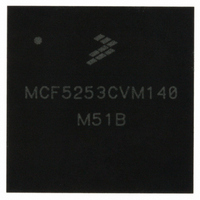MCF5253CVM140 Freescale Semiconductor, MCF5253CVM140 Datasheet - Page 411

MCF5253CVM140
Manufacturer Part Number
MCF5253CVM140
Description
IC MPU 32BIT 140MHZ 225-MAPBGA
Manufacturer
Freescale Semiconductor
Series
MCF525xr
Datasheets
1.MCF5253VM140J.pdf
(34 pages)
2.MCF5253VM140J.pdf
(8 pages)
3.MCF5253VM140J.pdf
(648 pages)
4.MCF5253VM140J.pdf
(2 pages)
Specifications of MCF5253CVM140
Core Processor
Coldfire V2
Core Size
32-Bit
Speed
140MHz
Connectivity
CAN, EBI/EMI, I²C, QSPI, UART/USART, USB OTG
Peripherals
DMA, WDT
Program Memory Type
ROMless
Ram Size
128K x 8
Voltage - Supply (vcc/vdd)
1.08 V ~ 1.32 V
Data Converters
A/D 6x12b
Oscillator Type
External
Operating Temperature
-40°C ~ 85°C
Package / Case
225-MAPBGA
Family Name
MCF5xxx
Device Core
ColdFire V2
Device Core Size
32b
Frequency (max)
140MHz
Instruction Set Architecture
RISC
Supply Voltage 1 (typ)
1.2/3.3V
Operating Supply Voltage (max)
1.32/3.6V
Operating Supply Voltage (min)
1.08/3V
Operating Temp Range
-40C to 85C
Operating Temperature Classification
Industrial
Mounting
Surface Mount
Pin Count
225
Package Type
MA-BGA
Lead Free Status / RoHS Status
Lead free / RoHS Compliant
Number Of I /o
-
Eeprom Size
-
Program Memory Size
-
Lead Free Status / Rohs Status
Compliant
Available stocks
Company
Part Number
Manufacturer
Quantity
Price
Company:
Part Number:
MCF5253CVM140
Manufacturer:
FREESCALE
Quantity:
300
Company:
Part Number:
MCF5253CVM140
Manufacturer:
Freescale Semiconductor
Quantity:
10 000
Part Number:
MCF5253CVM140
Manufacturer:
FREESCALE
Quantity:
20 000
Company:
Part Number:
MCF5253CVM140J
Manufacturer:
Freescale Semiconductor
Quantity:
10 000
- MCF5253VM140J PDF datasheet
- MCF5253VM140J PDF datasheet #2
- MCF5253VM140J PDF datasheet #3
- MCF5253VM140J PDF datasheet #4
- Current page: 411 of 648
- Download datasheet (8Mb)
Chapter 21
IEEE 1149.1 Test Access Port (JTAG)
This chapter discussed the JTAG signal descriptions, TAP controller, register descriptions, and how to
disable the standard operation.
The MCF5253 JTAG test architecture implementation currently supports circuit board test strategies that
are based on the IEEE standard. This architecture provides access to all of the data and chip control pins
from the board edge connector through the standard four-pin test access port (TAP) and the active-low
JTAG reset pin, TRST. The test logic uses static design and is wholly independent of the system logic,
except where the JTAG is subordinate to other complimentary test modes (see
Debug Mode (BDM)
placed in reset and the TAP pins can be used for other purposes in accordance with the rules and
restrictions set forth using a JTAG compliance-enable pin.
21.1
The MCF5253 JTAG implementation can do the following:
21.2
Figure 21-1
logic includes several test data registers, an instruction register, instruction register control decode, and a
16-state dedicated TAP controller.
Freescale Semiconductor
•
•
•
•
•
Perform boundary-scan operations to test circuit board electrical continuity
Bypass the MCF5253 by reducing the shift register path to a single cell
Sample the MCF5253 system pins during operation and transparently shift out the result
Set the MCF5253 output drive pins to fixed logic values while reducing the shift register path to a
single cell
Protect the MCF5253 system output and input pins from backdriving and random toggling (such
as during in-circuit testing) by placing all system signal pins to high- impedance state
Features
Block Diagram
is a block diagram of the MCF5253 implementation of the 1149.1A IEEE Standard. The test
The IEEE Standard 1149.1 test logic cannot be considered completely
benign to those planning not to use JTAG capability. Users must observe
certain precautions to ensure that this logic does not interfere with system or
debug operation. Refer to
Operation.”
Interface,”
for more information). When in subordinate mode, the JTAG test logic is
MCF5253 Reference Manual, Rev. 1
Section 21.7, “Disabling IEEE 1149.1A Standard
NOTE
Chapter 20, “Background
21-1
Related parts for MCF5253CVM140
Image
Part Number
Description
Manufacturer
Datasheet
Request
R
Part Number:
Description:
Mcf5253 Coldfire? Microprocessor Data Sheet
Manufacturer:
Freescale Semiconductor, Inc
Datasheet:
Part Number:
Description:
Manufacturer:
Freescale Semiconductor, Inc
Datasheet:
Part Number:
Description:
Manufacturer:
Freescale Semiconductor, Inc
Datasheet:
Part Number:
Description:
Manufacturer:
Freescale Semiconductor, Inc
Datasheet:
Part Number:
Description:
Manufacturer:
Freescale Semiconductor, Inc
Datasheet:
Part Number:
Description:
Manufacturer:
Freescale Semiconductor, Inc
Datasheet:
Part Number:
Description:
Manufacturer:
Freescale Semiconductor, Inc
Datasheet:
Part Number:
Description:
Manufacturer:
Freescale Semiconductor, Inc
Datasheet:
Part Number:
Description:
Manufacturer:
Freescale Semiconductor, Inc
Datasheet:
Part Number:
Description:
Manufacturer:
Freescale Semiconductor, Inc
Datasheet:
Part Number:
Description:
Manufacturer:
Freescale Semiconductor, Inc
Datasheet:
Part Number:
Description:
Manufacturer:
Freescale Semiconductor, Inc
Datasheet:
Part Number:
Description:
Manufacturer:
Freescale Semiconductor, Inc
Datasheet:
Part Number:
Description:
Manufacturer:
Freescale Semiconductor, Inc
Datasheet:
Part Number:
Description:
Manufacturer:
Freescale Semiconductor, Inc
Datasheet:











